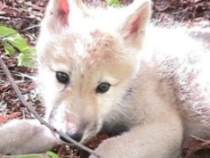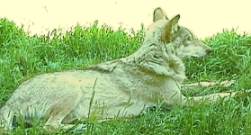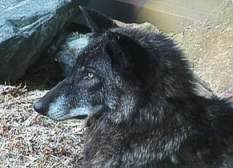International
Wolf Center
Ely,
Minnesota
218-365-4695
or 1-800-Ely-Wolf
July 03, 2000
 We
had heard so much about the International Wolf Center in Ely
Minnesota we couldn't pass up an opportunity to see it first
hand. The International Wolf Center is a nonprofit organization
that supports the survival of the wolf around the world by
teaching about its life, its associations with other species and
its dynamic relationship to humans. The Center offers many programs, a number of them consist of
going into the bush on overnight treks. Unfortunately we did not
have the time to explore any of those programs, but if you are
interested you can get more information from the Wolf Center.
We
had heard so much about the International Wolf Center in Ely
Minnesota we couldn't pass up an opportunity to see it first
hand. The International Wolf Center is a nonprofit organization
that supports the survival of the wolf around the world by
teaching about its life, its associations with other species and
its dynamic relationship to humans. The Center offers many programs, a number of them consist of
going into the bush on overnight treks. Unfortunately we did not
have the time to explore any of those programs, but if you are
interested you can get more information from the Wolf Center.
 The timing of our visit couldn't have been more
perfect, as they had just introduced to the Center, two 8 week
old Arctic Wolf cubs. They had named them: Malik and Shadow. You
can see actual video footage of these two on the Wolf Center's
website.
The Center itself is a beautiful building filled with information
about Wolves and their early beginnings. The Indians believed
that various animals were their brothers and as such treated them
with respect. For the most part Wolves seemed to do the same. It
is very unusual for Wolves to harm humans. However, livestock is
another matter and that is where they began to get into conflict
with ranchers
The timing of our visit couldn't have been more
perfect, as they had just introduced to the Center, two 8 week
old Arctic Wolf cubs. They had named them: Malik and Shadow. You
can see actual video footage of these two on the Wolf Center's
website.
The Center itself is a beautiful building filled with information
about Wolves and their early beginnings. The Indians believed
that various animals were their brothers and as such treated them
with respect. For the most part Wolves seemed to do the same. It
is very unusual for Wolves to harm humans. However, livestock is
another matter and that is where they began to get into conflict
with ranchers  as civilization began encroaching more and more
into the wilds. It was very interesting to see the different
stories that evolved over the ages. Nursery rhymes, such as Red
Riding Hood and The Three Little Pigs, tend to make the wolf not
only a villain but stupid as well. They are neither. Then we have
the ancient tales of "Wolf-men", possibly generated by
Indians who wore Wolf heads as ornamental dress, believing in
that way they could draw to themselves the power and bravery of
the wolves. Today the Center is working very hard to show the
wolves as they really are, to the public at large, in an effort
to save them and what habitat they have left.
In addition to the new cubs the Center currently has one male
(Lucas) and two female wolves (McKenzie) and (Lakota). The three
are all Plains wolves and they are all siblings. As soon as a
wolf is old enough they are spade or neutered to keep them
docile.
as civilization began encroaching more and more
into the wilds. It was very interesting to see the different
stories that evolved over the ages. Nursery rhymes, such as Red
Riding Hood and The Three Little Pigs, tend to make the wolf not
only a villain but stupid as well. They are neither. Then we have
the ancient tales of "Wolf-men", possibly generated by
Indians who wore Wolf heads as ornamental dress, believing in
that way they could draw to themselves the power and bravery of
the wolves. Today the Center is working very hard to show the
wolves as they really are, to the public at large, in an effort
to save them and what habitat they have left.
In addition to the new cubs the Center currently has one male
(Lucas) and two female wolves (McKenzie) and (Lakota). The three
are all Plains wolves and they are all siblings. As soon as a
wolf is old enough they are spade or neutered to keep them
docile.  As a result when a wolf dies, they have to send
to a registered breeder to get a new one. The Center just lost
one wolf from old age, and felt that they needed to get a
replacement. Well, how about two for one? Lucas, as the only male
is naturally the Alpha or leader wolf. The two females McKenzie
and Lakota also have their own pecking order. McKenzie is the
Alpha female and Lakota is the Beta. It was very interesting to
find out from Lori that the social or pecking order is very
important for the human handlers to observe. If a handler goes
into the compound with the adult wolves and should greet Lakota
first that would be a very bad social faux pas, kind of like
ignoring the Queen of England as you greet her husband first, eh?
Not only is a social error on the handlers part, Lakota would
actually be punished for it by the rest of the pack.
We found out with the cubs, as with any babies, they interact
with one another and with their handlers. Lori Schmidt was the
curator of the wolves. As such
As a result when a wolf dies, they have to send
to a registered breeder to get a new one. The Center just lost
one wolf from old age, and felt that they needed to get a
replacement. Well, how about two for one? Lucas, as the only male
is naturally the Alpha or leader wolf. The two females McKenzie
and Lakota also have their own pecking order. McKenzie is the
Alpha female and Lakota is the Beta. It was very interesting to
find out from Lori that the social or pecking order is very
important for the human handlers to observe. If a handler goes
into the compound with the adult wolves and should greet Lakota
first that would be a very bad social faux pas, kind of like
ignoring the Queen of England as you greet her husband first, eh?
Not only is a social error on the handlers part, Lakota would
actually be punished for it by the rest of the pack.
We found out with the cubs, as with any babies, they interact
with one another and with their handlers. Lori Schmidt was the
curator of the wolves. As such  she spends
most of her day bonding with the adult wolves as well as the
pups. Lori told us in the first couple of days that the cubs were
there, she actually slept in the enclosure with them to make sure
that they were adjusting to their new surroundings. I think it is
amazing when you meet people like Lori and their dedication to
animals. In order to obtain the pups for the Center we learned
that they contacted a breeder in Minneapolis that had a special
license from the State as well as several other agencies. When
the Center requested the pups they had to agree to find homes
(various zoos, agencies, etc.) for any of the litter they did not
take. People may find it cruel or inhuman for beautiful animals
like these to be raised in captivity, but as it was pointed out
to us, their mission in life is to educate humans about wolves,
thereby helping their fellow wolves in the wild. Although it is
obvious that the wolves have
she spends
most of her day bonding with the adult wolves as well as the
pups. Lori told us in the first couple of days that the cubs were
there, she actually slept in the enclosure with them to make sure
that they were adjusting to their new surroundings. I think it is
amazing when you meet people like Lori and their dedication to
animals. In order to obtain the pups for the Center we learned
that they contacted a breeder in Minneapolis that had a special
license from the State as well as several other agencies. When
the Center requested the pups they had to agree to find homes
(various zoos, agencies, etc.) for any of the litter they did not
take. People may find it cruel or inhuman for beautiful animals
like these to be raised in captivity, but as it was pointed out
to us, their mission in life is to educate humans about wolves,
thereby helping their fellow wolves in the wild. Although it is
obvious that the wolves have  accepted their handlers, they will never be what
the public calls domesticated. They don't learn "cute parlor
tricks" to do for the public. However, they do learn to
interact with humans so that they don't run and hide every time
someone comes by to look at them, or when they need to be treated
or fed. Since the cubs are so young they have to be fed on a
different schedule than the adult wolves and are kept at a
distance from the adult wolves for the time being. However, it is
beginning to look like Lucas is showing a protective attitude
towards the cubs already. Lakota as the Beta wolf is showing some
jealousy towards the cubs and anytime she does, Lucas is right
there explaining it to her in no uncertain terms that she can't
do that.
After
accepted their handlers, they will never be what
the public calls domesticated. They don't learn "cute parlor
tricks" to do for the public. However, they do learn to
interact with humans so that they don't run and hide every time
someone comes by to look at them, or when they need to be treated
or fed. Since the cubs are so young they have to be fed on a
different schedule than the adult wolves and are kept at a
distance from the adult wolves for the time being. However, it is
beginning to look like Lucas is showing a protective attitude
towards the cubs already. Lakota as the Beta wolf is showing some
jealousy towards the cubs and anytime she does, Lucas is right
there explaining it to her in no uncertain terms that she can't
do that.
After the cubs were shown to the public, we were
allowed behind the scenes with Lori and a couple of the Nannies
that help care for the cubs. It was interesting to find out that
the Nannies are people who actually pay for the privilege of
taking care of these little guys. Not that I wouldn't have paid
to do that, but unfortunately in addition you have to have some
background in animal care, and hopefully wolf care if possible.
One of the Nannies that we met was Nancy Weiss. She actually had
a skill in relaxation massage, which helped the cubs when they
were first there. We watched as Lori started doing a wolf howl.
It was amazing to watch, not only
the cubs were shown to the public, we were
allowed behind the scenes with Lori and a couple of the Nannies
that help care for the cubs. It was interesting to find out that
the Nannies are people who actually pay for the privilege of
taking care of these little guys. Not that I wouldn't have paid
to do that, but unfortunately in addition you have to have some
background in animal care, and hopefully wolf care if possible.
One of the Nannies that we met was Nancy Weiss. She actually had
a skill in relaxation massage, which helped the cubs when they
were first there. We watched as Lori started doing a wolf howl.
It was amazing to watch, not only the cubs, but the grown wolves
start howling in response. Lori explained to us that the howling
was a way of the wolves calling their pack together. It is
considered a "gathering" call. Even after Lori stopped
the wolves showed a good deal of agitation and pacing before they
were sure everything was OK and they calmed down. I applaud the Center for
what they are doing and can only hope that they succeed before
the earth is devoid of these beautiful, intelligent creatures. Be
sure and drop in on their website at: http://www.wolf.org and check up on the new cubs progress.
the cubs, but the grown wolves
start howling in response. Lori explained to us that the howling
was a way of the wolves calling their pack together. It is
considered a "gathering" call. Even after Lori stopped
the wolves showed a good deal of agitation and pacing before they
were sure everything was OK and they calmed down. I applaud the Center for
what they are doing and can only hope that they succeed before
the earth is devoid of these beautiful, intelligent creatures. Be
sure and drop in on their website at: http://www.wolf.org and check up on the new cubs progress.